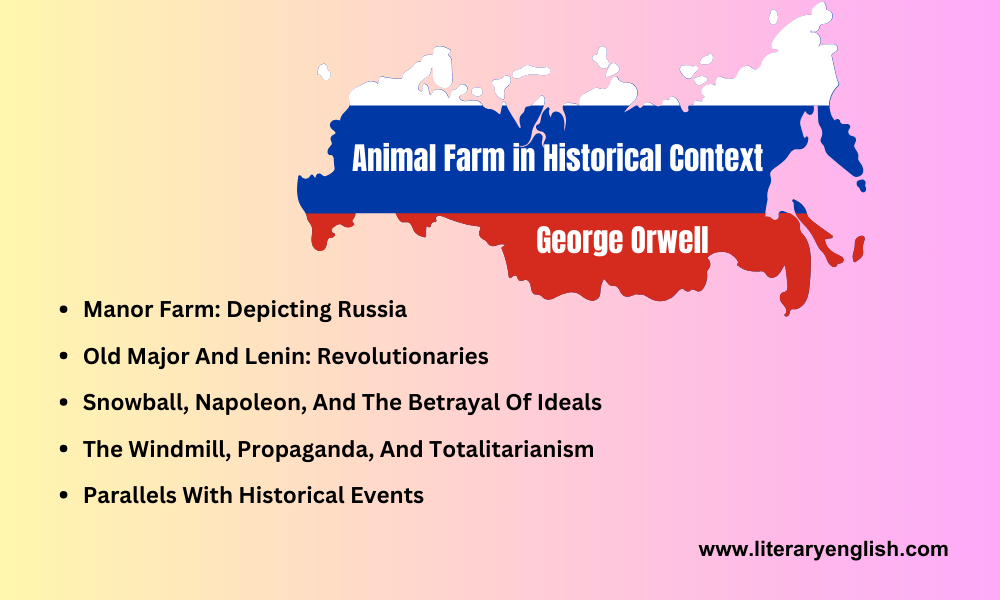In George Orwell’s renowned novella “Animal Farm,” the fictional narrative is intricately woven with historical events, primarily reflecting the tumultuous events of the Russian Revolution of 1917 and its aftermath. Through the allegorical portrayal of Manor Farm and its animal inhabitants, Orwell provides a scathing critique of the rise of totalitarianism, the manipulation of power, and the erosion of democratic ideals. A critical analysis of “Animal Farm” within its historical context unveils Orwell’s astute commentary on the Russian Revolution and its key figures.
Manor Farm: Depicting Russia
Orwell ingeniously utilizes Manor Farm as a microcosm of Russia, with Mr. Jones symbolizing Tsar Nicholas II, the autocratic ruler whose oppressive regime led to widespread discontent among the Russian populace. Jones’s mismanagement and neglect mirror the social and economic hardships endured by the Russian people under Nicholas’s reign, culminating in the Bolshevik Revolution.
Old Major and Lenin: Revolutionaries
The character of Old Major embodies the revolutionary fervor espoused by V. I. Lenin, the charismatic leader of the Bolshevik Party. Like Lenin, Old Major articulates a vision of societal transformation based on the principles of equality and collective ownership. Their deaths before witnessing the full realization of their ideals underscore the tragic irony of revolution.
Snowball, Napoleon, and the Betrayal of Ideals
Snowball and Napoleon represent the ideological struggle within the Bolshevik movement, with Snowball echoing the idealism and internationalism of Leon Trotsky. Conversely, Napoleon embodies the ruthless pragmatism and consolidation of power synonymous with Joseph Stalin. Orwell’s portrayal highlights the betrayal of revolutionary ideals and the descent into authoritarianism.
The Windmill, Propaganda, and Totalitarianism
The construction of the windmill symbolizes Stalin’s industrialization drive and propaganda machinery, mirroring the Soviet Union’s Five-Year Plans. Squealer’s manipulation of language and dissemination of falsehoods reflect the propaganda tactics employed by Stalinist regimes to control information and suppress dissent.
Parallels with Historical Events
Orwell meticulously parallels key historical events with fictional counterparts, including the Battle of the Cowshed mirroring the Russian Civil War, Frederick representing Adolf Hitler, and the Battle of the Windmill symbolizing the Soviet Union’s role in World War II.
Conclusion: Orwell’s Cautionary Tale
“Animal Farm” serves as a cautionary tale about the corrupting influence of power, the betrayal of revolutionary ideals, and the cyclical nature of oppression. Orwell’s astute analysis of historical events through allegory provides timeless insights into the fragility of democracy and the dangers of totalitarianism.
In conclusion, a critical analysis of “Animal Farm” in its historical context reveals Orwell’s profound understanding of the complexities of revolution and the human condition. By illuminating the parallels between fiction and reality, Orwell challenges readers to confront the enduring legacies of authoritarianism and the ongoing struggle for freedom and justice.
Related Posts from Animal Farm
- Plot Overview of Animal Farm
- Introduction To Animal Characters
- Chapter-Wise Summary
- Symbolism in Animal Farm
- Principal Theme of Animal Farm
- Animal Farm as an Allegory
- Character Analysis Of Old Major
- Snowball vs. Napoleon
- Symbolic Significance of Bleating Sheep
- The Song “Beasts Of England” In George Orwell’s
